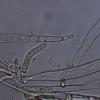
04-11-2025 09:07
Hello.A suspected Hymenoscyphus sprouting on a thi

04-11-2025 12:43
 Edvin Johannesen
Edvin Johannesen
Hi! One more found on old Populus tremula log in O

03-11-2025 21:34
 Edvin Johannesen
Edvin Johannesen
These tiny (0.4-0.5 mm diam.), whitish, short-stip

28-10-2025 15:37
Carl FarmerI'd be grateful for any suggestions for this strik

03-11-2025 16:30
 Hans-Otto Baral
Hans-Otto Baral
Hello I want to ask you if you have found this ye
Rutstroemia calopus on juncus effusus?
FranûÏois Bartholomeeusen,
29-04-2014 11:46
I send you a Word document with my find on juncus.
Is my determination correct? I have my doubts. In Breitenbach(vol. 1 p. 146) it should be stalkless but taking into account the taxonomic corrections the determination is correct! Ellis and Ellis p.498 confirms my conclusion, so am I right or am I wrong.
Thanks in advance, kind regards,
FranûÏois Bartholomeeusen
Hans-Otto Baral,
29-04-2014 12:15

Re : Rutstroemia calopus on juncus effusus?
Hi Francois
R. calopus is usually stalked. Your photo of an apically opened ascus in IKI shows a distinct bluing. Now important would be the ascus base. Did you see young asci emerging from the basal cells? Are there croziers or not?
There is a quite sharp delimitation between Poaceae (with croziers) and Cyperaceae/Juncaceae (without). From the substrate yours should be R. paludosa (or R. henningsiana which seems to be the older name).
There is a recent paper on this, by F. Pancorbo, Miguel-Angel Ribes et al. 2013.
Estudio micobiota ecosistema dunares Peninsula y Baleares I.
Bol. Soc. Micol. Madrid 37: 175-201
See also here
http://www.ascofrance.fr/search_forum/22183
Zotto
R. calopus is usually stalked. Your photo of an apically opened ascus in IKI shows a distinct bluing. Now important would be the ascus base. Did you see young asci emerging from the basal cells? Are there croziers or not?
There is a quite sharp delimitation between Poaceae (with croziers) and Cyperaceae/Juncaceae (without). From the substrate yours should be R. paludosa (or R. henningsiana which seems to be the older name).
There is a recent paper on this, by F. Pancorbo, Miguel-Angel Ribes et al. 2013.
Estudio micobiota ecosistema dunares Peninsula y Baleares I.
Bol. Soc. Micol. Madrid 37: 175-201
See also here
http://www.ascofrance.fr/search_forum/22183
Zotto
FranûÏois Bartholomeeusen,
29-04-2014 15:01
Hans-Otto Baral,
29-04-2014 20:15

Re : Rutstroemia calopus on juncus effusus?
Yes, I am sorry, it is not clear to me either.
Miguel ûngel Ribes,
06-05-2014 08:43

Re : Rutstroemia calopus on juncus effusus?
Hello FranûÏois
I am sending you the paper.
Good luck.
I am sending you the paper.
Good luck.
FranûÏois Bartholomeeusen,
06-05-2014 18:11
Re : Rutstroemia calopus on juncus effusus?
Dear Zotto and Miguel,
It is so nice to have friends...so far away... Many thanks for your help!
I revisited the site and with some difficulty discovered that the substrate is not Juncus effusus but Eleocharis palustris(Cyperaceae).
According to Bernard Declerck it's the first time that Rutstroemia paludosa was found in Flanders.
Kind regards,
FranûÏois
It is so nice to have friends...so far away... Many thanks for your help!
I revisited the site and with some difficulty discovered that the substrate is not Juncus effusus but Eleocharis palustris(Cyperaceae).
According to Bernard Declerck it's the first time that Rutstroemia paludosa was found in Flanders.
Kind regards,
FranûÏois
Bernard Declercq,
06-05-2014 19:14

Re : Rutstroemia calopus on juncus effusus?
Dear FranûÏois, Zotto and Miguel,
I checked the collection received from FranûÏois. The asci have indeed no croziers, onlyô a basal bent protuberance.
I am interested in receiving the Pancorbo & al. paper too. Thanks in advance.
Best regards,
Bernard
I checked the collection received from FranûÏois. The asci have indeed no croziers, onlyô a basal bent protuberance.
I am interested in receiving the Pancorbo & al. paper too. Thanks in advance.
Best regards,
Bernard
Hans-Otto Baral,
06-05-2014 20:55

Re : Rutstroemia calopus on juncus effusus?
Great, Bernard! So it is R. henningsiana/paludosa, confined to Cyperaceae and Juncaceae.
Zotto
Zotto

 GrasstromakelkjeAF-0001.docx
GrasstromakelkjeAF-0001.docx

